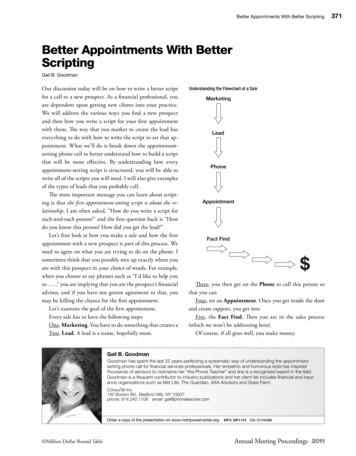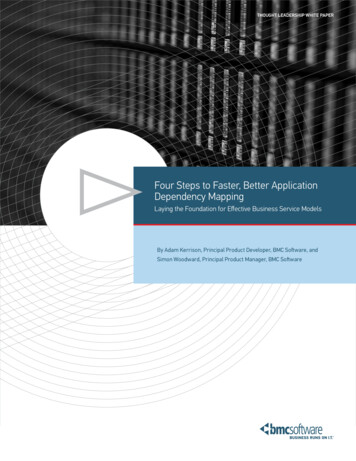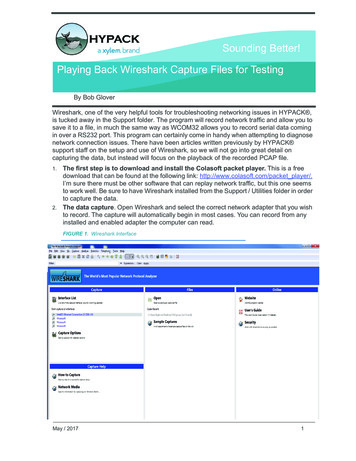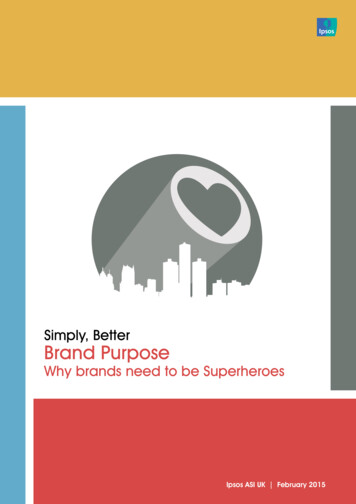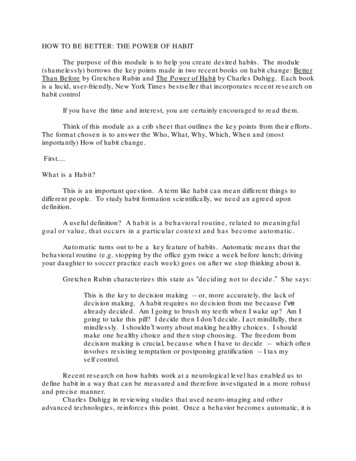
Transcription
HOW TO BE BETTER: THE POWER OF HABITThe purpose of this module is to help you create desired habits. The module(shamelessly) borrows the key points made in two recent books on habit change: BetterThan Before by Gretchen Rubin and The Power of Habit by Charles Duhigg. Each bookis a lucid, user-friendly, New York Times bestseller that incorporates recent research onhabit controlIf you have the time and interest, you are certainly encouraged to read them.Think of this module as a crib sheet that outlines the key points from their efforts.The format chosen is to answer the Who, What, Why, Which, When and (mostimportantly) How of habit change.First.What is a Habit?This is an important question. A term like habit can mean different things todifferent people. To study habit formation scientifically, we need an agreed upondefinition.A useful definition? A habit is a behavioral routine, related to meaningfulgoal or value, that occurs in a particular context and has become automatic.Automatic turns out to be a key feature of habits. Automatic means that thebehavioral routine (e.g. stopping by the office gym twice a week before lunch; drivingyour daughter to soccer practice each week) goes on after we stop thinking about it.Gretchen Rubin characterizes this state as “deciding not to decide.” She says:This is the key to decision making -- or, more accurately, the lack ofdecision making. A habit requires no decision from me because I’vealready decided. Am I going to brush my teeth when I wake up? Am Igoing to take this pill? I decide then I don’t decide. I act mindfully, thenmindlessly. I shouldn’t worry about making healthy choices. I shouldmake one healthy choice and then stop choosing. The freedom fromdecision making is crucial, because when I have to decide -- which ofteninvolves resisting temptation or postponing gratification -- I tax myself control.Recent research on how habits work at a neurological level has enabled us todefine habit in a way that can be measured and therefore investigated in a more robustand precise manner.Charles Duhigg in reviewing studies that used neuro-imaging and otheradvanced technologies, reinforces this point. Once a behavior becomes automatic, it is
regulated by a different part of the brain that is associated with less effort, less depletionof resources (what habit experts call ‘self-central reserves’).We have advanced from preaching about habit change, to the application ofbehavior modification strategies to effect it, to the discovery of a physical marker tomeasure it.Why Change?If you are taking the time to read this module, you already know the answer: youare investing effort and intellectual reserves to learn about habit change because thereis a new habit you want to create or some undesirable pattern you want to change.Meeting your goals and living your days more in line with your values is the mostimportant reason to change.In addition, relying on the findings of leading researchers and thinkers on habitchange and self-discipline, we can point to other benefits, such as: Improved healthLonger lifeCoping more effectively with stressIncreased happinessEnhanced self-esteemGreater respect from othersBetter professional successImproved focusGreater confidencePerhaps the key advantage of creating good habits is revealed in the abovenoted, research-driven definition of habit: habits conserve energy.After we decide what we want to change; (e.g. lose weight, spend more time withfamily) and once we figure out the behavioral routine to help get us there; and once thatroutine becomes automatic; then we can bank self-control reserves. With thosereserves, we can pursue other fulfilling endeavors and/or have a less harried, morepeaceful state of mind.Who is Changing?Who will create a new habit? You, of course. But who are you? With thisquestion, we are asking? Are there important qualities to know about yourself to helpcreate a new habit?” The answer is yes.Gretchen Rubin has identified four tendencies or personality types thatsignificantly inform how to establish a new habit. These tendencies are psychological
dispositions of how we respond to expectations. Expectations can be inner (e.g. NewYear’s Day Resolutions) or outer (e.g. work deadline). How do you respond to these twotypes of expectations? Depending on your answer you will fall into one of the fourgroups in the table below.OUTER elsUpholders respond well to outer and inner expectations. Habit change is theeasiest -- although not necessarily easy -- for this type.Questioners respond well to inner expectations, but not to outer expectations.Questioners need to be clear with themselves that creating a new habit is worthwhile.They tend not to be swayed by rules or other’s expectations. Once a Questionerdetermines their own rationale for a habit, they are more likely to be successful.Obligers do try to meet other’s expectations and are motivated by deadlines andrules. A core strategy for Obligers is to build in some kind of external accountability forhabit change, such as going to the gym with a friend or joining an exercise class orrunning group.Rebels fight inner and outer expectations. Habit change, therefore, is difficult forRebels ( Rubin estimates that Rebels make up 5% of the population ). One corestrategy is to encourage Rebels to identify habits that line up with their chosen values.Another strategy is to encourage them to think through the advantages anddisadvantages of developing a particular habit.ln addition to highlighting this key trait of how one responds to expectations, Rubinprovides a list of questions to identify other traits that can help one design a habitchange strategy. To wit:Am l a lark (morning person) or an owl (night person)?If you are a lark, you wouldn’t want to plan the time of your new habit (e.g.exercising, studying) after dinner.If you are an owl you probably don’t want to execute your new habit in the morningwhen you are not naturally energetic or productive.lf you are not clearly a lark or an owl, you may want to work on your new habit inthe morning. Research suggests we have more reserves of self-control earlier in the
day. And you may want to nudge your lark tendency: research also suggests larks are abit more happier and healthier than owls.Am l a marathoner, sprinter or procrastinator?A marathoner is someone who works in a deliberate, steady and slow manner.Marathoners accrue energy by seeing steady progress. Marathoners are not particularlymotivated by deadlines.Sprinters prefer quick bursts of energy. Sprinters do respond positively to thepressures of a deadline.Marathoners and sprinters appreciate their style of pace and increase thelikelihood of creating a new habit by working within that style. Thus, no need to changetheir style.Procrastinators are not happy with their work style and need to change it (more onhow later).Am l an underbuyer or overbuyer?An underbuyer hates to shop and buy. An overbuyer loves to shop and buy.How does this relate to habit change? An underbuyer should be encouraged tospend (e.g. acquire good running shoes) to support a new habit. An overbuyer needs torealize that acquisitions (“once l get the right equipment l will get in shape”) are, at best,minor factors in habit change.Am l a simplicity lover or an abundance lover?Simplicity lovers are drawn to “less” e.g. a roomy closet, bare surfaces, lesschoices, less noise.Abundance lovers are drawn to “more” e.g. a full closet, stocked shelves, morechoices, more stuff.Simplicity lovers work better in environments that are quiet and empty; abundancelovers generally prefer some bustle, and work spaces with rich visual detail.Simplicity lovers are drawn to habits that involve simplification and elimination(e.g. saving money, reducing caloric contact); whereas abundance lovers are drawn toaddition and variety (e.g. making more money, enriching their diet).Am l a finisher or a starter?Finishers are particularly satisfied when they finish a project. Starters are excitedby starting a project. Thus if a finisher wanted to cultivate the habit of creative writing,she might want to have a daily marker of accomplishment such as completing twoparagraphs: whereas a starter may want to reinforce her enthusiasm by exploringwebsites that offer writing tips.Am l a familiarity lover or a novelty lover?Familiarity lovers enjoy doing the same things e.g. vacationing at the same spot,eating the same foods. Habits become easier for such people when they becomefamiliar.Novelty lovers seek out new experiences. Such people may take to habits thatenable them to take on new projects and challenges.
Am l promotion-focused or prevention-focused?Am l focused on advancement and achievement; or avoiding losses and dangers?A promotion-focused person may increase their exercise routine to look moreattractive or become better at a sport; whereas a prevention-focused person mightexercise more to prevent health difficulties or injuries.Do l like to take big steps or small steps?For some people, having audacious goals gets them motivated. For most people,however, taking small steps is more realistic. The key is to take some small step.Research suggests that taking even very small steps (e.g. one pushup, writing onesentence, set alarm to wake up two minutes earlier) is predictive of taking the next stepand then the next step and so on.Fostering the habit of habit builds an infrastructure in your brain that makesvirtuous behavior more automatic. The result? More success in realizing your goals andthe freeing up of self-control reserves to take on more challenging goals.When To Start A Habit?NOW“Distance is nothing; it’s only the first step that is difficult.” Amelia Earhart.For most people the first step is the hardest; alas, it is also the most important.To help you take the first step, consider the following:One of the more exhausting states of mind is to focus on the unfinished task, theput-off resolution. Starting shifts the mind gear from this enervated mode to a moreenergized, productive mode.1.“ The first step binds one to the second” (French proverb). Taking the first step no matter how small - raises the chances of taking the next step.2.Reclaim the power of NOW. Tomorrow will always seem like a better time to start.But NOW is where life is lived, choices made, power asserted.3.Picture one of those old steam engine trains with large wheels. The train isrevving up to start a journey. The boilermen are expending sweat and muscle,pouring coal into the furnace, to get the train moving slowly out of the station. Fora moment you doubt whether the train has the energy to keep inching forward. Butit does. And in a few minutes the train is barreling down the tracks, makingheadway, carried by it’s own momentum.4.You may be in the group of people that responds better to starting with a big,demanding step (e.g. “Today l will write the first chapter of that book.” “l willschedule a 90 minute session with a trainer to jump start my exercise routine.”).For you, the challenge of a big step is energizing rather than intimidating. Knowyourself.
When To Stop a Habit?Try never, never works“ In the acquisition of a new habit, or the leaving of an old one, we must take careto launch ourselves with as strong and decided an effort as possible.Never suffer anexception to occur till the new habit is securely rooted in your life. Each lapse is like theletting fall of a ball of string which one is carefully winding up; a single slip undoes morethan than a great many times will wind again.”William James* The idea here is not to simply get rid of bad habits, but to replace them with habits thatare in line with your values, habits that you honestly want to incorporate in your life(e.g. eat healthy, exercise regularly, read carefully).* Beware of a finish line, a once-and-for-all goal (e.g. lose 30 lbs). A finish line is often aformula for relapse since it creates a vacuum that will eventually be filled by the oldpattern.* It is harder to restart a habit than continue one.Which Habits to Cultivate?We now know there are some habits that are “better” than others. These betterhabits have a synergistic quality. Thus, when these habits take root, they trigger otherdesirable habits. Therefore, there is a ‘get two (or even three) for one’ quality to thesehabits.Gretchen Rubin refers to these habits as foundational: Charles Duhigg labelsthem as keystone habits.In addition to making other habits easier to acquire, these habits:* Increase sense of well-being* Increase productivity* Increase willpowerThere is a good deal of consensus on which habits are foundational. Mostexperts emphasize the four habits listed below with their scientifically-proven benefits.Sleep
Energy level not depleted Reduce stress/risk of depression Improve attention and memory Live longer/maintain a healthy weightExercise Regularly Increase energy levelImprove mood/feeling of calmImprove executive functioningImprove health outcomes/weight maintenanceEat and Drink Well Increases productivityControls weightBoosts moodImproves healthDecluttering Saves time/boosts energy Greater sense of self-control Facilitates productivityKeystone habits -- habits that cause other good habits to fall in line -- are notnecessarily more difficult to acquire. Indeed, a key feature of keystone habits is thatthey provide a sense of small, but consistent victories.A good example of a keystone habit is keeping a food journal, in which you keepa record of everything you ate or drank during the week, the time and place, and theemotion you were having at the time. Every record-keeping act is a small, butconsistent success.It also establishes a routine that can trigger desirable changes. For example,you may notice you eat a lot while watching a football game, but are barely aware ofenjoying the food. Or you might notice you overeat when feeling anxious. Theseobservations can lead to changes in your eating routines that are not only healthier, butmay also increase your enjoyment of eating.
How To Create Desirable HabitsThis, of course, is the most important question. There have beenscores of books and hundreds of articles written on habit creation.Admittedly, there is not one, all - inclusive strategy for habit change. But, lcan offer a basic guideline that represents the state-of-the-art thinking ofhabit experts and has empirical support. To cultivate a desirable habit:Focus on adding a positive routine that can be integratedinto your daily life, a routine that reflects a cherished value.This is it. This guideline is the secret sauce, l will argue. Let’s break downthe specific ingredients of the guideline.Focus on adding a positive routine.* Research shows greater success and benefit in adding a positive newroutine (e.g. eating healthy, exercising regularly) than reducing negativeroutines (e.g. snacking frequently, sedentary lifestyle).* With habit control, the better aim is not to break bad habits, but tooutgrow them with good habit where we can flourish.* Adding positive routines may be the answer to the riddle of happiness. Increating positive routines based on our cherished values, we may verywell be stumbling toward what happiness research suggests may be theHoly Grail, namely:Happiness is the byproduct of the struggle to becomeyour ideal self.We now know that happiness is not associated with goodcircumstances, pleasure, a positive attitude, or even self-acceptance (it is important toaccept yourself, but also to expect more of yourself).Rather, long-term happiness and fulfillment involve the pursuit of what is mostvaluable and meaningful to you.Adding positive routines, thoughtfully chosen, is the concrete realization of thatpursuit.* Positive habits seem to have the potential to become self-reinforcing i.e. you feel likegoing to the gym; you develop a taste for more healthy foods; you want to be the oneto pick the kids up from soccer practice.The reward of the habit is the habit itself.that can be integrated into your daily life.* Focus on routines that are practiced every day and provide a continuous sense ofachievement (e.g. walk an extra 15 minutes per day: substitute a piece of fruit for apastry; ask about your partner’s most significant moment of the day; devote 20minutes a day to professional reading). The buildup of these kinds of routines - while
they might not sound as glamorous as pursuing such goals as running a marathon orearning 200k a year - are associated with long term success and fulfillment.* Good news: the synergistic habits mentioned in the previous section lend themselvesto daily routines.* Daily habits become automatic, thus reducing strain and effort. Remember,neuroscience has demonstrated the brain “wants” to conserve energy, wants todelegate activity from the higher (effortful) cortical functions to the lower (automatic)brain stem functions.The magic number for securing this automaticity? For most routines, the numberappears to be around 30. That is, when we practice the new routine for 30 daysconsecutively (or 30 times over a relatively brief period of time), it is much more likely toshift to automatic pilot mode, freeing up self-control resources (willpower) for otherchallenges.* When daily habits become more automatic we enter the realm of changing the way welive for the better forever. In so doing, we glide by the intimidating barrier of “ having todo this for the rest of my life.”* Brings into play what habit experts call STRETCH goals with the SMART system.STRETCH goals refer to an ambitious, vital desire (e.g. to be a good parent).STRETCH goals are what we want our life to be about, our life to stand for.The SMART system, developed in the corporate arena in the 1980’s emphasizesconcrete changes by requiring the following specific benchmarks:Specific - read to my daughter 20 minutes a dayMeasurable - keep a record of the readingAchievable - (think small) 20 minutes a dayRealistic - can always find 20 minutes a dayTimeline - (think short) read every day for a monthThe SMART system can weave STRETCH goals into the fabric of our life.and that reflects a cherished value.Identifying a routine that reflects a cherished value may be the mostpowerful component of habit change.How so?To answer this question we first have to distinguish between goals andvalues.Goals (e.g. lose 25 lbs by the summer; train to run a marathon by the fall)are often what get us thinking about cultivating desirable habits. Goals,like New Year’s resolutions, are specific accomplishments. Goals have afinish line. Realizing goals, particularly if they are ambitious, require agood deal of discipline and effort.Values are the answer to the essential question: What do l want my life tostand for? (e.g. be a loving parent; make a key contribution to thecommunity; live in line with my ethical standards; be a good provider).Values provide a direction to one’s life. Values are realized in a quality of
action. Values do not have a finish line - they are never finally or fullyrealized.If you think of life as a journey, then values provide you with a direction,while goals may be way-stations along the journey. The journey is bestundertaken as a marathon (daily routines) rather than a series of sprints(meeting one goal, then the next, and so on). Routines (e.g.reading to mychild every night) that reflect a cherished value (loving parent) are morelikely to shift into a (mindful) cruise control marathon.Daily routines that reflect a cherished value (loving parent), may not besexy or ambitious, but become the firmament of what you want your life tostand for.Examples of such routines:* Volunteer to take your son to soccer practice; read to your daughter every night (Value loving parent)* Walk an extra 20 minutes a day; substitute a piece of fruit for a cookie for midafternoon snack ( Value healthy lifestyle)* Read 20 minutes a day; periodically read challenging material ( Value deepenknowledge and understanding)* Get to work 15 minutes early; look for courses to bolster work-related skills ( Value be a productive worker)Now that we have clarified the difference between goals and values, we can identifythe advantages of cultivating daily routines (habits) that reflect - even if only in a smallway - cherished values.* Greater resilience. When we see the connection between the routine and the value,we are more able to stick with the routine when we hit difficult patches. For example, ifyou are stuck in a traffic jam taking your daughter to soccer practice, you appreciatethis means more time with your daughter, as well as an opportunity to model for herhow to deal with frustration.* Valued routines tap into intrinsic motivation i.e. we engage in the routine for its ownsake rather than for some future reward (extrinsic motivation). Research indicates thathabits based on intrinsic rewards are less fragile than habits based on externalrewards i.e. the reward of the habit is the habit itself.* No finish line. Meeting a specific goal implies a finish line. This means the desirablehabit stops, at least for a period of time. Why is this a problem? Because it is easier tocontinue a habit than to start it up again.* By living out our values daily, we undermine possible harsh, critical views of ourselves(e.g. “I’m lazy.incompetent.selfish”).* Adding routines that are linked to key values taps into the positivity principlementioned earlier. Habit formation is more likely to occur when we add a positiveroutine (e.g.take exercise class three times a week) rather than try to subtract a flaw(e.g. lose 24 lbs).
* Increase our baseline level of happiness. To extend the metaphor of life as a journey,imagine that you are driving the car on this “journey of life.” We are socialized to thinkthat the key to happiness is arriving at various desirable destinations (e.g. a beautifulspouse, high status job, seven figures in the retirement portfolio). But happinessresearch emphasizes that long term happiness is not correlated with arriving at suchdesirable destinations, but how much control we have over driving toward them.When we add meaningful daily routines, we reinforce our role as drivers i.e. weget up in the morning, get in the car, turn on the ignition, and drive the car in a chosendirection, even if the roads are a bit slippery that day.
Than Before by Gretchen Rubin and The Power of Habit by Charles Duhigg. Each book is a lucid, user-friendly, New York Times bestseller that incorporates recent research on habit control If you have the time
